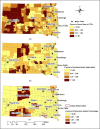Barriers of Female Breast, Colorectal, and Cervical Cancer Screening Among American Indians-Where to Intervene?
- PMID: 29546202
- PMCID: PMC5690412
- DOI: 10.3934/publichealth.2016.4.891
Barriers of Female Breast, Colorectal, and Cervical Cancer Screening Among American Indians-Where to Intervene?
Abstract
Female breast, colorectal, and cervical cancer are three common cancers among people in the United States. Both their incidence and mortality rates can be dramatically reduced if effective prevention and intervention programs are developed and implemented, because these cancers are preventable through regular screenings. American Indians in the United States especially in the Northern Plains have a disproportionally high burden of these cancers. As a hard-to-reach population group, less attention has been paid to American Indians regarding cancer screening compared with other population groups. This study examined barriers experienced by American Indians residing in South Dakota regarding three cancer sites: female breast, colorectal, and cervical cancer through a community-based survey. A total of 199 participants were recruited and factors significantly associated with cancer screening included knowledge about cancer screening, geographic access to PCPs, encouragement by doctors, as well as socioeconomic barriers. Meanwhile, integrating geographic access, socioeconomic deprivation, and geographic distribution of American Indians, the study identified geographic areas of low access to cancer screening where hard-to-reach populations resided. Results from the study will provide crucial information for the development of targeted intervention programs to increase the acceptability and uptake of cancer screening among American Indians.
Keywords: American Indians; barriers; cancer screening; geographic access.
Conflict of interest statement
Conflict of Interest: The authors declare no conflict of interest.
Figures
References
-
- American Cancer Society Cancer Facts & Figures 2016. Cancer Facts Fig. 2016:1–9.
-
- Cotterchio M, Manno M, Klar N, et al. Colorectal screening is associated with reduced colorectal cancer risk: a case–control study within the population-based Ontario Familial Colorectal Cancer Registry. Cancer Causes Control. 2005;16:865–875. - PubMed
LinkOut - more resources
Full Text Sources
Other Literature Sources
Research Materials


